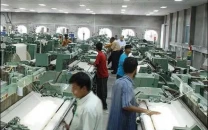Seven Indian soldiers killed by Pakistan Army on LoC
7 Indian soldiers killed, 19 injured in retaliatory fire after Indian aggression

Pakistani Army soldiers manning a post on the LoC. Photo: AFP/File
While seven Indian soldiers were also killed and 19 others injured in retaliatory fire.
Unprovoked, indiscriminate ceasefire violations by #India at LOC resulted in shahadat of an 18 y/o boy & injuries to 3 women today. Deliberate targeting of civilians is condemnable.
— Dr Mohammad Faisal (@DrMFaisal) April 2, 2019
Indian forces had targetted Pakistani positions in the Rakhchakri area of Rawalakot Sector. As a result of the skirmish, Subedar Muhammad Riaz from Jhang, Lance Havaldar Azizullah from Noshero Feroz and Sepoy Shahid Mansib from Abbottabad were martyred.
It’s your turn to get ready for surprise, Pakistan Army tells India
Another soldier sustained injuries in the incident.
Moreover, an 18-year-old boy was martyred while three women sustained injuries from unprovoked Indian firing.
How the Indo-Pak tensions escalated
Tensions escalated dramatically between Pakistan and India on February 14 when a young man – a native of the Indian occupied Kashmir (IoK) – rammed an explosives-laden car into an Indian military convoy, killing at least 44 soldiers.
India was quick to blame the state of Pakistan for the suicide bombing. Prime Minister Imran offered every possible help in the investigation, but India turned down the offer and whipped up war hysteria.
4 civilians martyred, 10 injured in uprovoked Indian fire along LoC
On February 26, the Indian Air Force (IAF) violated Pakistani airspace. The country’s top civil and military leadership declared the violation of airspace by Indian fighter jets “uncalled for aggression” and decided that the country would respond at a “time and place of its choosing”.
On February 27, Pakistan announced it had shot down two Indian fighter jets that attempted to violate its airspace and captured an Indian pilot. The military’s media wing later released a video of the pilot, who introduced himself as Wing Commander Abhinandan bearing service number 27981.
Director-General Inter-Services Public Relations (ISPR) Major General Asif Ghafoor said in a press conference that the armed forces had responsibly retaliated to Indian incursion by striking a target few miles from an Indian military’s administrative unit to ensure there were no human life or collateral damage.“We decided to not hit a military target or endanger human life. We did not want to retaliate at the cost of regional peace. We do not want escalation,” he told reporters.
India asks Pakistan to ‘do more’
A few hours later, Prime Minister Imran Khan took the nation into confidence over the armed forces’ response. As escalating tensions fuelled concerns of all-out war between nuclear-tipped Pakistan, Imran warned of catastrophic consequences should “better sense” not prevail. The premier ended his speech with another peace talks offer and cooperation in Pulwama attack investigation to India.
On February 28, the Foreign Office (FO) said it received a dossier on the Pulwama attack from the Indian government. It added that the government was deliberating whether to treat Abhinandan as a prisoner of war (POW) or apply any international convention.
In the evening, PM Imran addressed a joint session of the parliament and announced that Pakistan would release the captured pilot as a goodwill gesture to de-escalate tensions.
On March 1, Pakistan ‘as a goodwill gesture’ handed over to Indian authorities the captured IAF Wing Commander Abhinandan Varthaman as the nuclear-armed neighbours scaled back a confrontation that has prompted world powers to urge restraint.
Other states including the United States, Saudi Arabia, United Arab Emirates (UAE), UK and the European Union (EU) were involved in both overt and covert diplomacy to find a way out of the impasse between the two nuclear-armed arch-rivals.












1726134115-0/BeFunk_-(41)1726134115-0-208x130.webp)






COMMENTS
Comments are moderated and generally will be posted if they are on-topic and not abusive.
For more information, please see our Comments FAQ